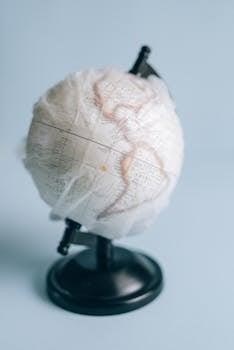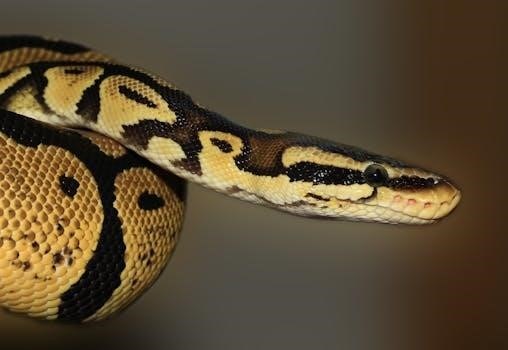Ball pythons are popular pets, known for their docile nature, and relatively simple care needs. This guide offers a comprehensive overview for both beginner and experienced reptile keepers. Proper habitat setup, correct feeding, and gentle handling are key to their well-being. Ball pythons can live for 20-30 years, making them a long-term commitment.
Understanding Ball Pythons as Pets
Ball pythons, also known as royal pythons, are among the most popular pet snakes due to their manageable size, calm temperament, and relatively straightforward care requirements. They are nocturnal creatures, meaning they are most active at night, which can be an interesting observation for pet owners. These snakes are non-venomous constrictors, relying on their muscular strength rather than venom to subdue their prey. They are generally docile and not prone to biting, which makes them suitable for both beginners and experienced reptile enthusiasts. However, it’s important to understand their specific needs to provide a healthy and comfortable environment. Ball pythons can grow to be 3-5 feet long as adults, with females typically growing slightly larger than males. Their lifespan can range from 20 to 30 years or even longer with proper care, requiring a long-term commitment from their caretakers. They come in a wide variety of colors and patterns, known as morphs, making them visually appealing and adding to their popularity as pets.

Ball Python Biological Facts
Ball pythons, scientifically known as Python regius, are non-venomous constrictors native to Central Africa. They are relatively small pythons, with a stocky build and a lifespan of 20-30 years, reaching 3-5 feet in length.
Natural Habitat and Size
Ball pythons originate from the savannahs, grasslands, and sparsely wooded areas of Central Africa. These nocturnal snakes are well-adapted to their environment, where they often seek shelter in burrows and termite mounds. They are known for their relatively small size compared to other pythons. Hatchlings typically measure around 10-16 inches in length, while adult males average 2-3 feet, and females usually range from 3-5 feet, though they can sometimes reach up to 6 feet. Their stocky build contributes to their weight, which can range from 3-4 pounds, and occasionally exceed 7 pounds in adulthood. Understanding their natural habitat and size is crucial for creating an appropriate captive environment that meets their needs and ensures their well-being, as well as anticipating the growth they will go through.
Lifespan and Growth
Ball pythons are known for their impressive lifespan, typically ranging from 20 to 30 years, and with proper care, some can even live up to 40 years. Their growth is relatively steady, with young ball pythons growing about a foot each year for the first three years, reaching their adult size by this age. Hatchlings start at 10-16 inches and gradually grow to their full adult length, with females often being larger than males. Regular checkups and consistent, high-quality care are key to maximizing their lifespan and ensuring healthy growth. Providing the right environment, nutrition, and veterinary care throughout their life stages is crucial for their longevity and overall well-being. Monitoring their growth can also help determine if any adjustments to their care are needed.

Creating the Ideal Habitat
A proper ball python habitat is crucial for their health, and well-being. It should mimic their natural African savannah environment, with correct temperature, humidity, and secure hiding spots. A spacious enclosure with proper ventilation is also necessary.
Enclosure Setup and Design
Setting up the right enclosure is vital for a ball python’s well-being. Adult ball pythons require a spacious tank, at least 36 inches long, to allow for adequate movement. Ensure the enclosure has a secure lid to prevent escapes, as these snakes are surprisingly good at finding their way out. Proper ventilation is also crucial for maintaining air quality and preventing respiratory issues. The enclosure should have a temperature gradient, with a warm side and a cool side, allowing the snake to regulate its body temperature. Include at least two hides, one on each side, providing the snake with secure and comfortable places to retreat. Adding climbing decor, such as branches, can enrich the environment and encourage natural behaviors. The overall design should prioritize the snake’s comfort and security, creating a habitat that mimics their natural environment.
Temperature and Humidity Control
Maintaining the correct temperature and humidity levels is crucial for the health of your ball python. A proper temperature gradient should be established within the enclosure, with the warm side ranging from 80-96°F for basking and the cool side around 80-85°F. Use reliable heat sources, such as heat lamps or under-tank heaters, paired with a thermostat for precise control. Humidity should be maintained between 50-70%, with an increase to 70% during shedding to help the snake shed its skin properly. Use a hygrometer to monitor humidity levels and mist the enclosure as needed to maintain the proper moisture. Good ventilation is important to prevent stagnant air and respiratory issues. Proper climate management is essential for a happy and healthy ball python, ensuring the snake can thrive in its habitat.

Substrate and Hiding Spots
Selecting the right substrate is important for your ball python’s health. Aspen shavings or cypress mulch are good options. Provide secure hiding spots, like caves or boxes, on both warm and cool sides. Adding plants can enrich the habitat.
Choosing the Right Substrate
Selecting the appropriate substrate is crucial for your ball python’s well-being, influencing humidity, hygiene, and overall comfort. Aspen shavings are a popular choice due to their absorbency, low dust levels, and natural feel. Cypress mulch is another excellent option, known for its ability to maintain humidity effectively, mimicking a more natural environment. Avoid cedar or pine shavings, as these can be harmful to reptiles. Consider the ease of cleaning when making your decision; some substrates require more frequent changes than others. A good substrate should also allow for burrowing, which is a natural behavior for ball pythons. Always ensure that the substrate is free from chemicals, dyes, and dust to provide a healthy environment for your pet snake. Regular substrate changes are important in maintaining a clean and hygienic habitat and preventing the growth of bacteria. Properly chosen substrate contributes to your snake’s health, well-being, and overall happiness in its enclosure.

Essential Care Products
Providing proper care involves using the right equipment, including feeding tools, heat sources, and monitoring devices. These products ensure your ball python’s health, safety, and overall well-being within its habitat. Investing in quality items is essential for responsible snake ownership.
Feeding Tools and Safety
When feeding your ball python, safety is paramount, for both you and your snake. Using long, stainless-steel feeding tweezers is highly recommended. These tools allow you to offer food from a safe distance, preventing accidental bites. The no-slip serrated tips provide a secure grip on the prey item, ensuring it doesn’t drop. Always offer pre-killed rodents to avoid the risk of injury to your python. Appropriate sized prey items, roughly the width of the snake’s body, are essential for digestion. Maintain a regular feeding schedule, typically once a week for juveniles and every 10-14 days for adults. Proper hygiene of feeding tools is crucial in preventing the spread of bacteria. Clean all feeding instruments thoroughly after each use. By following these guidelines, feeding will be a safe and stress-free process for your ball python and you.
Heating and Monitoring Equipment
Maintaining the correct temperature gradient within your ball python’s enclosure is crucial for its health. A reliable reptile tank clamp lamp fixture is essential for providing a consistent heat source. Opt for a fixture with a ceramic socket for durability and safety. It should also include a dimmer to allow for precise temperature adjustments. Never use heat rocks, as they can cause burns. A thermostat is vital for regulating the heat output, preventing overheating and ensuring a stable environment. Accurate temperature readings are necessary, so a digital thermometer is a must have. Also, a humidity gauge, is needed to maintain the proper humidity level. These tools will allow you to keep your ball python comfortable and thriving.
